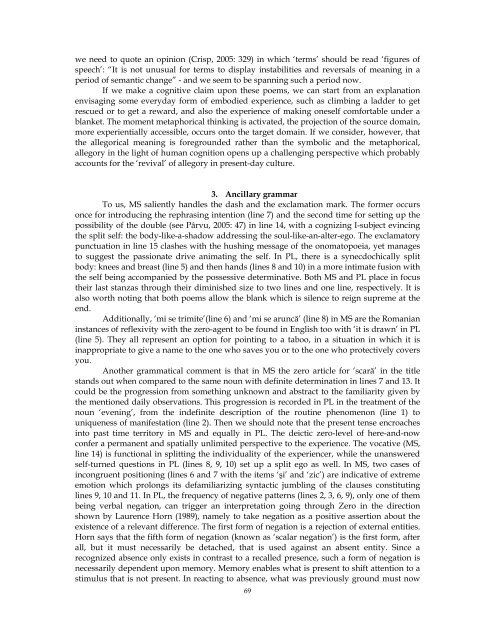You also want an ePaper? Increase the reach of your titles
YUMPU automatically turns print PDFs into web optimized ePapers that Google loves.
we need to quote an opinion (Crisp, 2005: 329) in which ‘terms’ should be read ‘figures of<br />
speech’: “It is not unusual for terms to display instabilities and reversals of meaning in a<br />
period of semantic change” - and we seem to be spanning such a period now.<br />
If we make a cognitive claim upon these poems, we can start from an explanation<br />
envisaging some everyday form of embodied experience, such as climbing a lad<strong>de</strong>r to get<br />
rescued or to get a reward, and also the experience of making oneself comfortable un<strong>de</strong>r a<br />
blanket. The moment metaphorical thinking is activated, the projection of the source domain,<br />
more experientially accessible, occurs onto the target domain. If we consi<strong>de</strong>r, however, that<br />
the allegorical meaning is foregroun<strong>de</strong>d rather than the symbolic and the metaphorical,<br />
allegory in the light of human cognition opens up a challenging perspective which probably<br />
accounts for the ‘revival’ of allegory in present-day culture.<br />
3. Ancillary grammar<br />
To us, MS saliently handles the dash and the exclamation mark. The former occurs<br />
once for introducing the rephrasing intention (line 7) and the second time for setting up the<br />
possibility of the double (see Pârvu, 2005: 47) in line 14, with a cognizing I-subject evincing<br />
the split self: the body-like-a-shadow addressing the soul-like-an-alter-ego. The exclamatory<br />
punctuation in line 15 clashes with the hushing message of the onomatopoeia, yet manages<br />
to suggest the passionate drive animating the self. In PL, there is a synecdochically split<br />
body: knees and breast (line 5) and then hands (lines 8 and 10) in a more intimate fusion with<br />
the self being accompanied by the possessive <strong>de</strong>terminative. Both MS and PL place in focus<br />
their last stanzas through their diminished size to two lines and one line, respectively. It is<br />
also worth noting that both poems allow the blank which is silence to reign supreme at the<br />
end.<br />
Additionally, ‘mi se trimite’(line 6) and ‘mi se aruncă’ (line 8) in MS are the Romanian<br />
instances of reflexivity with the zero-agent to be found in English too with ‘it is drawn’ in PL<br />
(line 5). They all represent an option for pointing to a taboo, in a situation in which it is<br />
inappropriate to give a name to the one who saves you or to the one who protectively covers<br />
you.<br />
Another grammatical comment is that in MS the zero article for ‘scară’ in the title<br />
stands out when compared to the same noun with <strong>de</strong>finite <strong>de</strong>termination in lines 7 and 13. It<br />
could be the progression from something unknown and abstract to the familiarity given by<br />
the mentioned daily observations. This progression is recor<strong>de</strong>d in PL in the treatment of the<br />
noun ‘evening’, from the in<strong>de</strong>finite <strong>de</strong>scription of the routine phenomenon (line 1) to<br />
uniqueness of manifestation (line 2). Then we should note that the present tense encroaches<br />
into past time territory in MS and equally in PL. The <strong>de</strong>ictic zero-level of here-and-now<br />
confer a permanent and spatially unlimited perspective to the experience. The vocative (MS,<br />
line 14) is functional in splitting the individuality of the experiencer, while the unanswered<br />
self-turned questions in PL (lines 8, 9, 10) set up a split ego as well. In MS, two cases of<br />
incongruent positioning (lines 6 and 7 with the items ‘şi’ and ‘zic’) are indicative of extreme<br />
emotion which prolongs its <strong>de</strong>familiarizing syntactic jumbling of the clauses constituting<br />
lines 9, 10 and 11. In PL, the frequency of negative patterns (lines 2, 3, 6, 9), only one of them<br />
being verbal negation, can trigger an interpretation going through Zero in the direction<br />
shown by Laurence Horn (1989), namely to take negation as a positive assertion about the<br />
existence of a relevant difference. The first form of negation is a rejection of external entities.<br />
Horn says that the fifth form of negation (known as ‘scalar negation’) is the first form, after<br />
all, but it must necessarily be <strong>de</strong>tached, that is used against an absent entity. Since a<br />
recognized absence only exists in contrast to a recalled presence, such a form of negation is<br />
necessarily <strong>de</strong>pen<strong>de</strong>nt upon memory. Memory enables what is present to shift attention to a<br />
stimulus that is not present. In reacting to absence, what was previously ground must now<br />
69












